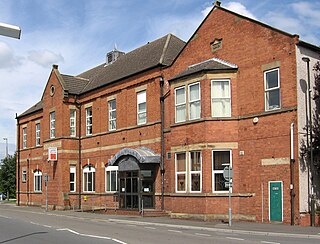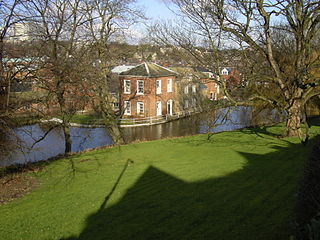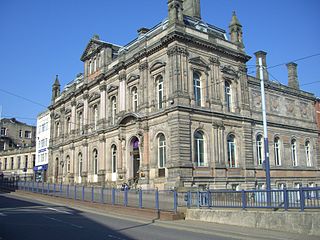
Sheaf House was a nine-storey tower building by Sheaf Square, next to Sheffield railway station, in the centre of Sheffield, in South Yorkshire, England. The building was formerly the Sheffield area headquarters of British Rail.

Sheaf House was a nine-storey tower building by Sheaf Square, next to Sheffield railway station, in the centre of Sheffield, in South Yorkshire, England. The building was formerly the Sheffield area headquarters of British Rail.
The building was situated on the former Pond Street Goods station, closed on 7 October 1961. Land was cleared during 1963 to make way for the new offices. Sheaf House was built with a reinforced concrete frame, finished with modern (at the time) metal and glass cladding. The building was opened in 1965 and housed 500 staff who had been transferred from the Midland Railway old offices in Norfolk House. Line control offices at Rotherham Westgate and Victoria were also closed and transferred to Sheaf House, becoming British Rail's Sheffield Division headquarters.
The building was demolished in late 2005 to make way for the redevelopment of Sheaf Square. This action featured on Channel 4's Demolition television programme.
There had previously been several proposals for refurbishing the building, including transforming it into a 180 bedroom hotel. The latest proposal along with the adjacent Dyson House site is for a futuristic mixed use scheme designed by Make Architects (Ken Shuttleworth) designer of the Swiss Re (Gerkin) in London. [1] The scheme is partial funded by EU regeneration grants and Yorkshire Forward as part of the Heart of the City projects masterplan to regenerate the area. The site forms part of the E-campus development currently underway on the site of the former Sheaf Baths site opposite the station and adjacent to the Pond Street bus station.

Staveley is a town and civil parish in the Borough of Chesterfield, Derbyshire, England. Located along the banks of the River Rother. It is northeast of Chesterfield, west of Clowne, northwest of Bolsover, southwest of Worksop and southeast of Sheffield.

The River Sheaf in Sheffield, South Yorkshire, England, flows northwards, past Dore, through Abbeydale and north of Heeley. It then passes into a culvert, through which it flows under the centre of Sheffield before joining the River Don. This lower section of the River Sheaf, together with the Don between the Blonk Street and Lady's Bridges, formed two sides of the boundary of Sheffield Castle.

The Porter Brook is a river which flows through the City of Sheffield, England, descending over 1,000 feet (300 m) from its source on Burbage Moor to the west of the city to its mouth where it joins the River Sheaf in a culvert beneath Sheffield railway station. Like the other rivers in Sheffield, its steep gradient made it ideal for powering water mills and works associated with the metalworking and cutlery industries, and around 20 dams were constructed over the centuries to facilitate this. At its lower end, it is extensively culverted, but parts of it are gradually being restored to open channels, as part of a daylighting scheme for the city.

Sheffield station is a combined railway station and tram stop in Sheffield, England; it is the busiest station in South Yorkshire, and the second busiest in Yorkshire & the Humber, after Leeds. Adjacent is the Sheffield Supertram stop.

Ponds Forge International Sports Centre is a leisure complex in Sheffield, England. It has an Olympic-sized swimming pool with 2,600 seating capacity, a family and children's pools, water slides amongst other facilities.

Parkgate is a suburb of Rotherham, South Yorkshire, England. It has since been consumed by its neighbour, Rawmarsh and is in the ward of Rawmarsh from which it has been indistinguishable since the early 20th century.

Hull Paragon Interchange is a transport interchange providing rail, bus and coach services located in the city centre of Kingston upon Hull, England. The G. T. Andrews-designed station was originally named Paragon Station, and together with the adjoining Station Hotel, it opened in 1847 as the new Hull terminus for the growing traffic of the York and North Midland (Y&NMR) leased to the Hull and Selby Railway (H&S). As well as trains to the west, the station was the terminus of the Y&NMR and H&S railway's Hull to Scarborough Line. From the 1860s the station also became the terminus of the Hull and Holderness and Hull and Hornsea railways.

Fitzalan Square is a municipal square situated in the city centre of Sheffield in South Yorkshire, England. The present day square is one of the busiest areas of the city centre, with traffic and pedestrians continually moving through the area. It has a Sheffield Supertram stop and a taxi rank.

The Meers Brook is a stream in Sheffield, England and one of the main tributaries of the River Sheaf. The Meers Brook originates in Gleadless and flows downhill through Gleadless Valley and Meersbrook then, culverted, continues underneath Heeley to pour into the River Sheaf near Saxon Road and Clyde Road in Lowfield.

Sheaf Square is a municipal square lying immediately east of the city centre of Sheffield, England.

Dyson House was a building which was part of Sheffield Hallam University's city campus in Sheffield, South Yorkshire, England. The building was on Sheaf Square, next to the Sheffield Midland Station. Dyson House became unused by the university for several years, and was bought by Yorkshire Forward as part of the Heart of the city scheme funded by EU regeneration money and was demolished in 2006. The site along with the adjacent Sheaf House has a proposal for a new 200,000 sq ft (19,000 m2) office block, shops and 200 apartments in a mixed use scheme of a futuristic modern design by Make Architects designers of the acclaimed Swiss Re (Gerkin) building in London.

Sheffield City Centre is a district of the City of Sheffield and is covered partly by the City ward of the City of Sheffield. It includes the area that is within a radius of roughly 0.75 miles (1.2 km) of Sheffield Cathedral and is encircled by the Inner Ring Road, a circular route started in the late 1960s and completed in 2007. As well as the cathedral, buildings in the city centre include the Grade I listed Town Hall, the City Hall and the Winter Gardens. Several areas of the city centre have been designated as quarters. It is home to the city's major business, transport, leisure and cultural attractions.
The Sheffield District Rail Rationalisation Plan was a series of linked railway civil engineering projects, station and line closures and train route changes that took place in and around Sheffield, South Yorkshire. The majority of these changes took place in the 1960s and early 1970s, however the plan, by now much modified in the face of rapidly dwindling freight traffic, was not fully realised until the 1980s.
Heart of the City II is a mixed-use development under construction in Sheffield city centre, England between the Devonshire Quarter and The Moor Gateway. The project was previously given the marketing name Sevenstone, prior to Hammerson, the developer, being dropped from the project in December 2013 with Sheffield City Council seeking new developers.

Manchester Mayfield is a former railway station in Manchester, England, on the south side of Fairfield Street next to Manchester Piccadilly station. Opened in 1910, Mayfield was constructed as a four-platform relief station adjacent to Piccadilly to alleviate overcrowding. In 1960, the station was closed to passengers and, in 1986, it was permanently closed to all services having seen further use as a parcels depot.

The Castlegate Quarter is one of the eleven quarters of Sheffield city centre. It is named after Castlegate, the quarter's main thoroughfare. The boundaries of the Castlegate Quarter are formed by Castlegate and the River Don to the north, Exchange Place to the east, Commercial Street and part of the High Street to the south, and Angel Street and Snig Hill to the west. For the latter part of the 20th century, the Castlegate Quarter was dominated by Castle Market, a large indoor market building. Following the demolition of Castle Market in 2015, the quarter is now undergoing regeneration as of 2020.

The Sheffield Digital Campus is a new development in Sheffield City Centre close to the railway station and bus station.

Canada House, formerly known as Panache House, is a Grade II* listed building situated on the northern side of Commercial Street in the centre of the city of Sheffield, South Yorkshire, England. It was built as the head offices of the Sheffield United Gas Light Company in 1874. While the main outlook of the building is out onto Commercial Street there is also a short frontage onto Shude Hill at its eastern end and this designated as 19 Shude Hill.

Bradford Crossrail is an idea to link together Bradford's two railway stations, Bradford Forster Square and Bradford Interchange. Both these stations are truncated versions of former station sites, Bradford Forster Square station and Bradford Exchange. These stations were built in the nineteenth century by different railway companies with an individual, rather than a comprehensive plan for rail development in the city.
Aldwarke Junction at Parkgate near Rotherham, South Yorkshire, England is a major railway junction. It was constructed in 1965 as a part of the Sheffield district rail rationalisation plan.
53°22′39.6″N1°27′49.6″W / 53.377667°N 1.463778°W